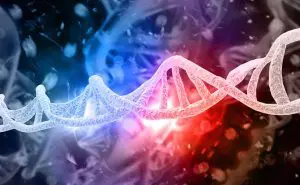15q11.2 deletion syndrome, also known as Prader-Willi syndrome or Angelman syndrome, is a designated incurable disease caused by a genetic abnormality.
What is 15q11.2 deletion syndrome?
The 15q11.2 deletion syndrome includes the following two syndromes:
- Prader-Willi syndrome
- Angelman syndrome
The following are details on the characteristics, causes, symptoms, complications, and treatment of the two syndromes:
Prader-Willi Syndrome
Characteristics
One in 15,000 children develop severe hypotonia and feeding difficulties in early infancy, and after the age of three, obesity that leads to overeating in late infancy is a characteristic of the syndrome. Other characteristics of Prader-Willi syndrome include delayed language and motor development, stubborn and obsessive personality, and short stature and strabismus.
Causes
The cause of Prader-Willi syndrome is not clearly identified even in modern medicine, but it is believed that 70% of cases are caused by partial deletion of all paternal autosomal regions of chromosomes q11 and q13 of chromosome 15 inherited from the parents, and 20% of cases are caused by chromosome 15 maternal dysomy.
Prada-Willi syndrome is not hereditary, and no known family-onset cases of epi-mutation have been reported.
Complications
Complications of Prader-Willi syndrome include breathing problems, diabetes, myopia, hyperopia, strabismus, and cutaneous paresthesia.
Other issues that affect patients and their families the most are personality disorders and aberrant behavior, two of the most common symptoms that patients and their families must deal with for the rest of their lives.
Another effective way to prevent complications is to be careful in day-to-day living.
Diet and nutritional management is extremely important, and we recommend that a thorough daily calorie count be performed, as once a person becomes obese, it is difficult to lose weight.
Treatments
There are four treatment options available:
- Exercise Treatment
- Sex Hormone Replacement Treatment
- Growth Hormone Replacement Treatment
- Dietary Treatment
All four treatments listed above are accepted worldwide and have been shown to be effective for Prader-Willi syndrome.
Other therapies, while they still tend to be under-recognized worldwide, include treatments for mental disorders, and both specifically are currently under study and are the subject of future research.
These are the four main treatments for Prader-Willi syndrome, of which Growth Hormone Treatment is considered to be the most effective.
Other very effective ways to work are thorough nutritional management from the early stages of the disorder.

Angelman Syndrome
Characteristics
Angelman Syndrome is a severe intellectual disability, an intractable disease that affects 1 in 15,000 people.
Symptoms include jerky movements and quick laughter at the slightest thing, and their appearance is characterized by a large mouth and a prominent chin.
They are also characterized by a high level of curiosity and an interest in accessories and other shiny things.
Causes
It is believed to be caused by loss of function of the UBE3A gene at positions q11 and q13 on chromosome 15.
Genetic abnormalities are also believed to be the mechanism by which the UBE3A gene loses its function.
Complications
The following are six of the most common complications of Angelman syndrome:
- Developmental Delay
- Cardiac complications
- Respiratory failure
- Severe Mental Retardation
- Strabismus
- Intractable Epilepsy
In addition to the six complications listed above, other symptoms of complications may be observed.
Treatments
As for treatments for Angelman syndrome, no definitive cure has yet been found anywhere in the world.
Currently, the main treatment is symptomatic therapy, specifically medication and counseling to alleviate the distress caused by the symptoms that have surfaced.
However, it is not a definitive treatment and is not expected to be directly effective for Angelman syndrome.
What is All Autosomal Whole Region Partial Deletion Disease?
About 80% of all autosomal whole region partial deletion diseases show a 2q37 deletion on chromosome testing, and the remaining 20% are due to deletions that are so small that they can only be detected by deletion analysis, although there are various testing methods available.
It tends to occur in about 0.7 out of every 1,000 people and is not inherited from a parent or ancestor, but is caused by a mutation during egg and sperm production.
The main symptoms include hernia, gastrointestinal abnormalities, visceral retroversion, and tracheomalacia.
In addition, partial deletion of all autosomal regions causes mild to moderate developmental delay and mental retardation, and the appearance of the child is characterized by an obese build and short stature.
Thus, all autosomal whole region partial deletion diseases have a variety of symptoms and are currently difficult to test for. However, with the all autosomal whole region partial duplication disease test, it is possible to perform an excellent test with a low chance of missing minute abnormalities.

NIPT(Non-invasive Prenatal Testing)
The 15q11.2 deletion syndromes Prader-Willi and Angelman syndromes introduced so far are caused by genetic factors and mutations, but it is possible to check whether the baby is healthy and sound before birth by using NIPT (Non-invasive Prenatal Testing).
The testing procedure specifically involves drawing blood from the mother of the baby and performing a blood test to determine the baby’s chromosomal abnormalities.
In addition, testing for all autosomal whole region partial deletion diseases is available for the following five syndromes:
- 1p36 Deletion Syndrome <\li>
- 4p Deletion Syndrome (Wolff-Hirschhorn Syndrome) <\li>
- 5p Deletion Syndrome (Cri-du-chat Syndrome) <\li>
- 15q11.2 Deletion Syndrome (Prada-Willi Syndrome and Angelman Syndrome) <\li>
- 22q11.2 Deletion Syndrome (Di George Syndrome)<\li>
Each of these syndromes will be discussed in detail.
1p36 Deletion Syndrome
It is one of the chromosomal abnormality syndromes characterized by neurological symptoms such as hypotonia and psychomotor development and a face characteristic of 1p36 deletion syndrome.
Other symptoms include severe mental retardation, growth retardation, and intractable epilepsy.
4p Deletion Syndrome (Wolff-Hirschhorn syndrome)
It is an over-chromosomal syndrome caused by deletion of a group of genes located on the short arm of chromosome 4 and is characterized by growth retardation, multiple shape abnormalities, and severe mental development.
It is also a government-designated chronic childhood disease, with an occurrence rate of 1 in 50,000 children.
5p Deletion Syndrome (Cri-du-chat Syndrome)
It is a syndrome of chromosomal abnormalities caused by partial deletion of the short arm of chromosome 5.
The main symptoms include high-pitched crying, abnormal fingers and toes, growth retardation, and decreased muscle tone.
15q11.2 Deletion Syndrome (Prada-Willi Syndrome and Angelman Syndrome)
It is a chromosomal abnormality syndrome caused by deletion of the 15q11-13 region of chromosome 15, and is characterized by symptoms such as hypomyotonia and hypopigmentation.
They may also have complications such as cleft palate, hypocalcemia, and impaired Immunity.
22q11.2 Deletion Syndrome (Di George Syndrome)
It is a chromosomal abnormality syndrome caused by a microdeletion of chromosome 22, q11.2.
It is a disease characterized by delayed mental development, impaired immunity, and hypocalcemia as its main symptoms, and it occurs in 1 in 4,000 to 5,000 people.
Hiro Clinic NIPT offers testing for these all autosomal partial deletion diseases at the Tokyo Clinical Laboratory, and can also perform testing for all autosomal partial deletion and duplication diseases in addition to the above-mentioned all autosomal partial deletion diseases
Summary
How was it? In this article, we introduced 15q11.2 deletion syndrome (Prader-Willi syndrome and Angelman syndrome).
15q11.2 deletion syndrome is considered a designated incurable disease caused by a genetic abnormality, which is also known specifically as Prader-Willi syndrome or Angelman syndrome.
The major difference between accredited and non-accredited facilities is whether or not people over 35 years of age can take the test, and we recommend that you select the facility that best suits your needs based on your own age.
We urge you to use what we have described in this article to investigate disorders of genetic abnormalities, such as 15q11.2 deletion syndrome, by using NIPT (Non-invasive Prenatal Testing).
【References】
- Intractable Disease Information Center – プラダー・ウィリ症候群(指定難病193)
- Intractable Disease Information Center – アンジェルマン症候群(指定難病201)
15q11.2 deletion syndrome, also known as Prader-Willi syndrome or Angelman syndrome, is a designated incurable disease caused by a genetic abnormality.
Article Editorial Supervisor

岡 博史先生
【役職】
【資格】
【略歴】
【所属】
【SNS】
 中文
中文













